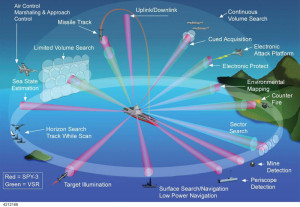 |
| Enhanced Flight Deck a key part of new Carrier |
PCU Gerald R. Ford (CVN-78) is to be the lead ship of its class of United States Navy supercarriers. As announced by the U.S. Navy on 16 January 2007, the ship is named after the 38th President of the United States Gerald R. Ford, whose World War II naval service included combat duty aboard the light aircraft carrier Monterey in the Pacific Theater.[6]
The keel of Gerald R. Ford was laid down on 13 November 2009.[2] Construction began on 11 August 2005, when Northrop Grumman held a ceremonial steel cut for a 15-ton plate that forms part of a side shell unit of the carrier. She was christened on 9 November 2013.[1] The schedule calls for the ship to join the U.S. Navy's fleet in 2016. Gerald R. Ford will enter the fleet replacing the inactive USS Enterprise (CVN-65), which ended its 51 years of active service in December 2012.[7][8]
Performance improvements promised
Gerald R. Ford is intended to be the first of a class of aircraft carriers that offer significant performance improvements over the previous Nimitz-class aircraft carrier. Gerald R. Ford is equipped with a phased array radar, and an island that is shorter in length and 20 feet (6.1 m) taller than that of the Nimitz-class; it is set 140 feet (43 m) further aft and 3 feet (0.91 m) closer to the edge of the ship. Electromagnetic catapults (EMALS) will launch aircraft, eliminating the need to store water and heat it for steam catapults. Gerald R. Ford can accomplish 25% more aircraft launches per day than the Nimitz-class and requires 25% fewer crew members. The Navy estimates it will save $4 billion in operating costs over a 50 year lifespan.[36] According to an Associated Press story:
"'She is truly a technological marvel,' Chief of Naval Operations Adm. Jonathan Greenert said in a webcast ceremony at the Newport News, Va., shipyard where Gerald R. Ford is being built. 'She will carry unmanned aircraft, joint strike fighters, and she will deploy lasers.'"[37]However these performance enhancers have proven problematic in Pentagon tests.[38]
Navy’s new $12b aircraft carrier beset with performance problems - Nation - The Boston Globe
About 60 percent of the ship, which like its predecessors will be nuclear powered, is based on the Nimitz design, while the remaining 40 percent consists of entirely new components — including a larger flight deck and high-tech systems. It is many of those new technologies that are encountering serious problems, Pentagon leaders have been told.
Primary among them is the so-called EMALS electromagnetic aircraft launch system, which is replacing the steam-powered catapult system long used to launch jets off the deck. The new system features a 100,000-horsepower linear electric motor, with a slide that accelerates along a giant rail. It has the ability launch multiple planes, one after the other, at a rapid pace.
Land-based tests of the system in New Jersey have demonstrated a reliability rate of only 240 launches without a failure, when it should be above 1,250 launches without failure at this stage of the Gerald Ford’s development.
Meanwhile, a companion system, known as the advanced arresting gear, which is designed to safely snare landing aircraft with cables stretched across the deck, is similarly unreliable, according to the report. In the tests, the system of cables has averaged 20 successful landings without failure. That is far less than the 4,950 successful landings it should be achieving without failure. The ultimate goal is for the system to work 16,500 times without failure.
Unless the various problems are resolved, the Pentagon weapons testers warned, the Gerald Ford will not be able to fly the number of wartime sorties envisioned by Navy planners, and two carriers might be needed to achieve the same effect of one.
The launch and landing systems are both being built by California-based General Atomics. Gary Hopper, vice president at the company, declined to respond to questions.
In testing phase, new carrier plagued by problems - News - Stripes
In addition to the launching and landing systems for jet fighters,
officials are also concerned about its advanced radar system, AN/SPY-3. It also
remains unclear if a key weapons elevator will work as promised.
According to the authors, “Poor reliability of these critical systems
could cause a cascading series of delays during flight operations that
would affect [the ship’s] ability to generate sorties, make the ship
more vulnerable to attack, or create limitations during routine
operations,” the Globe reports.
The Ford uses an AEGIS class radar, employing six Dual-Band Radar (DBR) panels developed by Raytheon for both the DDG-1000 Zumwalt-class guided missile destroyers and the Ford-class aircraft carriers. By replacing six to ten different radar antennas with a single six-faced multi-mission radar, attached to the outer walls, the island can be kept smaller. The DBR works by distributing multiple emitters of X-Band AN/SPY-3 multi-function radar and S-band Volume Search Radar (VSR) emitters, distributed into phased arrays. Each system has three phased array faces.
A number of other systems, such as communications gear, meanwhile, are
performing at less than acceptable standards, according to the
assessment by J. Michael Gilmore, the Pentagon’s director of operational test and evaluation. Gilmore concluded that the Navy has little choice
but to redesign key components of the ship.

No comments:
Post a Comment